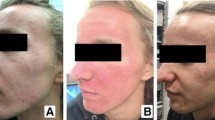Abstract
Usage of photopneumatic technology has recently increased for treatment of different skin conditions such as acne, keratosis pilaris (KP), and rosacea. Photopneumatic devices combine gentle negative pressure with broad band pulsed light simultaneously to attack multiple targets in the skin for better treatment outcomes. In this literature review, we evaluate the efficacy of photopneumatic therapy on treatment of acne, keratosis pilaris (KP), and rosacea.
Similar content being viewed by others
References
Alexiades M (2017) Laser and light-based treatments of acne and acne scarring. Clin Dermatol 35(2):183–189. https://doi.org/10.1016/j.clindermatol.2016.10.012
Pei S, Inamadar AC, Adya KA, Tsoukas MM (2015) Light-based therapies in acne treatment. Indian Dermatol Online J 6(3):145–157. https://doi.org/10.4103/2229-5178.156379
Kleinpenning MM, Smits T, Frunt MH, van Erp PE, van de Kerkhof PC, Gerritsen RM (2010) Clinical and histological effects of blue light on normal skin. Photodermatol Photoimmunol Photomed 26(1):16–21. https://doi.org/10.1111/j.1600-0781.2009.00474.x
Goldberg DJ, Russell BA (2006) Combination blue (415 nm) and red (633 nm) LED phototherapy in the treatment of mild to severe acne vulgaris. J Cosmet Laser Ther 8(2):71–75. https://doi.org/10.1080/14764170600735912
Ianosi S, Neagoe D, Calbureanu M, Ianosi G (2013) Investigator-blind, placebo-controlled, randomized comparative study on combined vacuum and intense pulsed light versus intense pulsed light devices in both comedonal and papulopustular acne. J Cosmet Laser Ther 15(5):248–254. https://doi.org/10.3109/14764172.2013.814464
Taylor M, Porter R, Gonzalez M (2014) Intense pulsed light may improve inflammatory acne through TNF-alpha down-regulation. J Cosmet Laser Ther 16(2):96–103. https://doi.org/10.3109/14764172.2013.864198
Harris JD, Quatman CE, Manring MM, Siston RA, Flanigan DC (2014) How to write a systematic review. Am J Sports Med 42(11):2761–2768. https://doi.org/10.1177/0363546513497567
Malik MA (2014) How to write an introduction and methods of a systematic review of literature. J Pak Med Assoc 64(10):1208–1210
Ciliberto H, Farshidi A, Berk D, Bayliss S (2013) Photopneumatic therapy for the treatment of keratosis pilaris. J Drugs Dermatol 12(7):804–806
Kim JH, Chang SH, Cho MK, Kim BS (2009) Novel photopneumatic therapy for the treatment of rosacea. Ann Dermatol 21(3):268–273. https://doi.org/10.5021/ad.2009.21.3.268
Narurkar VA, Gold M, Shamban AT (2013) Photopneumatic technology used in combination with profusion therapy for the treatment of acne. J Clin Aesthet Dermatol 6(9):36–40
Lee EJ, Lim HK, Shin MK, Suh DH, Lee SJ, Kim NI (2012) An open-label, split-face trial evaluating efficacy and safty of photopneumatic therapy for the treatment of acne. Ann Dermatol 24(3):280–286. https://doi.org/10.5021/ad.2012.24.3.280
Omi T (2012) Photopneumatic technology in acne treatment and skin rejuvenation: histological assessment. Laser Ther 21(2):113–123. https://doi.org/10.5978/islsm.12-OR-07
Wanitphakdeedecha R, Tanzi EL, Alster TS (2009) Photopneumatic therapy for the treatment of acne. J Drugs Dermatol 8(3):239–241
Shamban AT, Enokibori M, Narurkar V, Wilson D (2008) Photopneumatic technology for the treatment of acne vulgaris. J Drugs Dermatol 7(2):139–145
Omi T, Munavalli GS, Kawana S, Sato S (2008) Ultrastructural evidence for thermal injury to pilosebaceous units during the treatment of acne using photopneumatic (PPX) therapy. J Cosmet Laser Ther 10(1):7–11. https://doi.org/10.1080/14764170701762427
Gold MH, Biron J (2008) Efficacy of a novel combination of pneumatic energy and broadband light for the treatment of acne. J Drugs Dermatol 7(7):639–642
Boen M, Brownell J, Patel P, Tsoukas MM (2017) The role of photodynamic therapy in acne: an evidence-based review. Am J Clin Dermatol 18(3):311–321. https://doi.org/10.1007/s40257-017-0255-3
Kawada A, Aragane Y, Kameyama H, Sangen Y, Tezuka T (2002) Acne phototherapy with a high-intensity, enhanced, narrow-band, blue light source: an open study and in vitro investigation. J Dermatol Sci 30(2):129–135
Elman M, Slatkine M, Harth Y (2003) The effective treatment of acne vulgaris by a high-intensity, narrow band 405-420 nm light source. J Cosmet Laser Ther 5(2):111–117
Omi T, Bjerring P, Sato S, Kawana S, Hankins RW, Honda M (2004) 420 nm intense continuous light therapy for acne. J Cosmet Laser Ther 6(3):156–162. https://doi.org/10.1080/14764170410023785
Tzung TY, Wu KH, Huang ML (2004) Blue light phototherapy in the treatment of acne. Photodermatol Photoimmunol Photomed 20(5):266–269. https://doi.org/10.1111/j.1600-0781.2004.00109.x
Morton CA, Scholefield RD, Whitehurst C, Birch J (2005) An open study to determine the efficacy of blue light in the treatment of mild to moderate acne. J Dermatolog Treat 16(4):219–223. https://doi.org/10.1080/09546630500283664
Ammad S, Gonzales M, Edwards C, Finlay AY, Mills C (2008) An assessment of the efficacy of blue light phototherapy in the treatment of acne vulgaris. J Cosmet Dermatol 7(3):180–188. https://doi.org/10.1111/j.1473-2165.2008.00386.x
Papageorgiou P, Katsambas A, Chu A (2000) Phototherapy with blue (415 nm) and red (660 nm) light in the treatment of acne vulgaris. Br J Dermatol 142(5):973–978
Kwon HH, Lee JB, Yoon JY, Park SY, Ryu HH, Park BM, Kim YJ, Suh DH (2013) The clinical and histological effect of home-use, combination blue-red LED phototherapy for mild-to-moderate acne vulgaris in Korean patients: a double-blind, randomized controlled trial. Br J Dermatol 168(5):1088–1094. https://doi.org/10.1111/bjd.12186
Liu LH, Fan X, An YX, Zhang J, Wang CM, Yang RY (2014) Randomized trial of three phototherapy methods for the treatment of acne vulgaris in Chinese patients. Photodermatol Photoimmunol Photomed 30(5):246–253. https://doi.org/10.1111/phpp.12098
Wiegell SR, Wulf HC (2006) Photodynamic therapy of acne vulgaris using methyl aminolaevulinate: a blinded, randomized, controlled trial. Br J Dermatol 154(5):969–976. https://doi.org/10.1111/j.1365-2133.2005.07107.x
Li WH, Fassih A, Binner C, Parsa R, Southall MD (2017) Low-level red LED light inhibits hyperkeratinization and inflammation induced by unsaturated fatty acid in an in vitro model mimicking acne. Lasers Surg Med. https://doi.org/10.1002/lsm.22747
Ravnbak MH (2010) Objective determination of Fitzpatrick skin type. Dan Med Bull 57(8):B4153
Lyon L (2008) An advance against acne. A vacuumlike device is defeating some really tough cases. US News World Rep 144(16):68
Ballin JS, Uebelhoer NS (2009) The use of the low-fluence 1064 nm Nd:YAG laser in a female with contraindications to systemic anti-acne therapy. J Drugs Dermatol 8(11):1025–1026
Author information
Authors and Affiliations
Corresponding author
Ethics declarations
Conflict of interest
The authors declare that they have no conflicts of interest.
Rights and permissions
About this article
Cite this article
Rajabi-Estarabadi, A., Choragudi, S., Camacho, I. et al. Effectiveness of photopneumatic technology: a descriptive review of the literature. Lasers Med Sci 33, 1631–1637 (2018). https://doi.org/10.1007/s10103-018-2619-1
Received:
Accepted:
Published:
Issue Date:
DOI: https://doi.org/10.1007/s10103-018-2619-1




